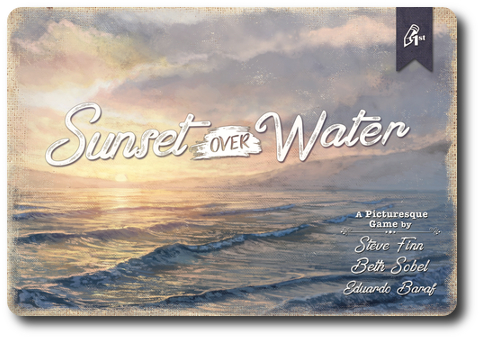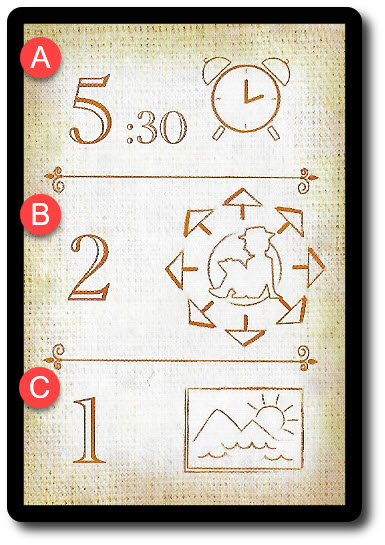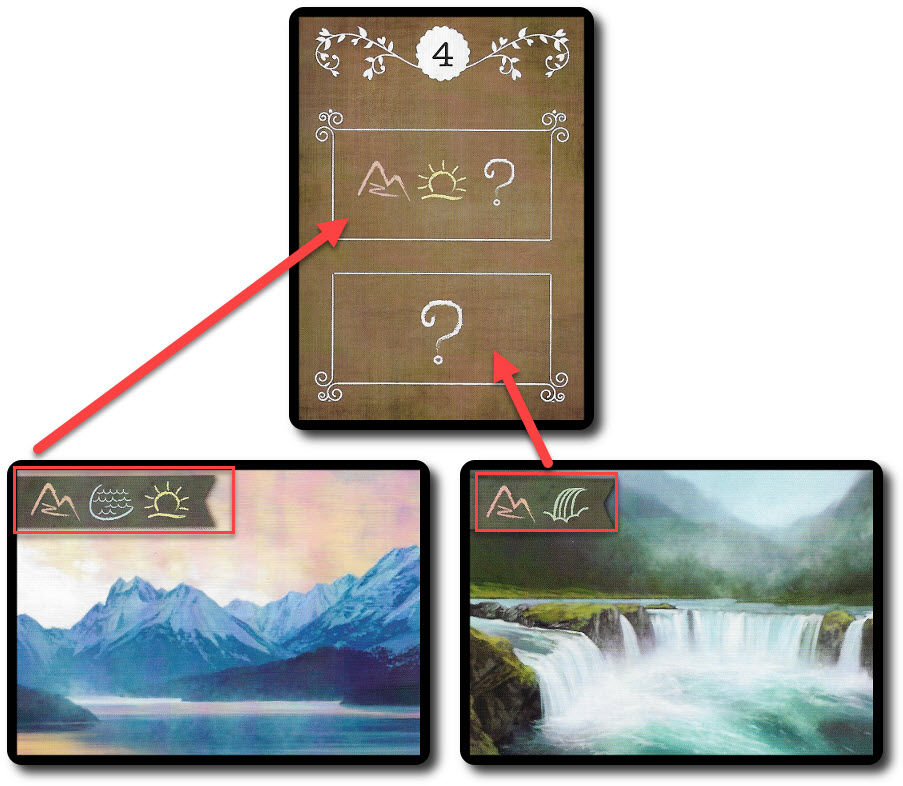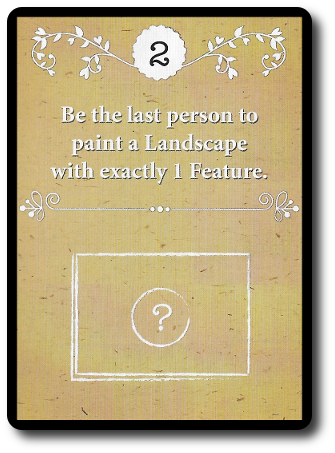
The Basics:
- For ages 8 and up
- For 1 to 4 players
- Approximately 20 minutes to complete
Geek Skills:
- Counting & Math
- Logical & Critical Decision Making
- Reading
- Pattern/Color Matching
- Strategy & Tactics
- Risk vs. Reward
- Hand/Resource Management
Learning Curve:
- Child – Easy
- Adult – Easy
Theme & Narrative:
- A successful artist knows how to spend their time wisely
Endorsements:
- Gamer Geek approved!
- Parent Geek approved!
- Child Geek approved!
Overview
American aviator, military officer, author, inventor, explorer, and environmental activist, Charles Lindbergh, said “Life is like a landscape. You live in the midst of it but can describe it only from the vantage point of distance.” Landscape paintings attempt to capture the full view of a moment in time. Artists hike to remote locations to find that special vantage point where the sky and ground, light and shadow, depth and vision merge into a perfect picture at a precise moment. In this game, you have the same task, but plan your day wisely. Distance and time are not an artist’s friend.
Sunset Over Water, designed by Eduardo Baraf, Steve Finn, Keith Matejka and published by Pencil First Games, is comprised of 60 Landscape cards, 30 Commission cards, 32 Planning cards, 7 Daily Goal cards, 4 Artist tokens (little meeples that look like reclining artists), 10 Solo Variant cards, and 4 Quick Reference cards. The game component quality is excellent, being primarily comprised of thick and durable cards. Artists Benjamin Shulman, Beth Sobel, and Helen Zhu have created a game about art that is bright and colorful. If you like landscapes, this is the game for you.
Prepping the Art Supplies
To set up the game, first take the Landscape cards and shuffle. Randomly draw 25 and place face-up in the middle of the playing area to form a 5 x 5 grid of cards. This area is referred to as the “Wilderness”. Place the remaining Landscape cards face-down next to the Wilderness. This is the Landscape draw deck for the duration of the game. Leave space for a discard pile.
Second, take the Commission cards and shuffle. Place this deck of cards face-down next to the Landscape draw deck. This is the Commission draw deck for the duration of the game. From this deck, draw one card per player, plus one additional card. Place these cards face-up in a row next to the Commission draw deck. This row is referred to as the “Commission Row”. Draw the top-most card from the Commision deck and place it face-up on top of the deck.
Fourth, take the Daily Goal cards and shuffle. Place this deck of cards face-down near the Commission Row. This is the Daily Goal draw deck for the duration of the game. Draw one Daily Goal card from this deck and place it face-up for all players to see.
Fifth, have each player select an Artist token and eight Planning cards of their color choice (cards and token should be the same color), placing the Artist token in the center Landscape card in the Wilderness.
Sixth, have each player shuffle their Planning cards and place the deck face-down in front of them. This is the player’s personal Planning draw deck. The deck is placed in the player’s “Play Area”.
That’s it for game set up. Time to create some art.
In Search of Art and Beauty
Sunset Over Water is played in rounds, phases, and turns for a total of six rounds. Each round is considered one day. A typical game round is summarized here.
Phase One: Plan Your Day
Each player draws the top three cards from their personal Planning deck and takes a look at them. Each Planning card shows three different pieces of information. The first is “Wake Up” time, which indicates when the player’s artist will shuffle out the door to start their day of painting. The second is “Hike” direction, which indicates the movement the player’s Artist will take through the Wilderness from its current position. The third is “Paint”, which indicates the number of paintings the player’s Artist will attempt to complete during the round. To summarize:
- A: Wake Up time determines player order
- B: Hike direction determines Artists token movement in the Wilderness
- C: Paint determines the number of Landscape cards the player can attempt to collect this turn

Before making their selection, players should review not only what Landscape cards are in front of them, but also what their opponent’s have collected, the currently available Commission cards, and the current Daily Goal that is available as these cards will all influence what Planning card the player will want to play based on their strategy and tactics. After they decide, the player places their selected Planning card in front of them face-down and the remaining two at the bottom of their personal Planning deck.
Once all players have selected their Planning card for the round, all players simultaneously reveal them.
Phase Two: Trek the Wilderness
Turn order during this phase is determined by the Wake Up time value noted on each player’s Planning card. The player with the earliest time of the day goes first, followed by the second earliest, and so on.
When it’s the player’s turn, the player can (all are optional) take the following three actions in any order that makes the most sense to them.
Action: Hike
This action lets the player move their Artist token in the Wilderness using the Hike direction shown on their selected Planning card for this round. The player must move their Artist token in accordance to the movement rule provided by their Planning card. The number indicates the number of Landscape cards the Artist can move at maximum and the direction arrows the Artists token can move from its current position (horizontally, vertically, and diagonally).
A few rules on movement, of course…
- Artist tokens can pass through other Artist tokens, but only one Artist token can occupy a Landscape card at a time (artist are territorial)
- Artist tokens cannot pass through vacant spaces (currently empty spaces in the Wilderness 5 x 5 grid where a Landscape card used to be)
- Artist tokens cannot change direction while moving (the directions available to the player are noted as arrows on the player’s selected Planning card for the round)
- Players are not required to use all or even any of their movement
Action: Paint
After the player has had a chance to move their Artist token, they may (again, optional) collect certain Landscape cards their Artist token passed through. Again, there are rules to follow here.
- The number of Landscape cards the player can collect is determined by the Paint number found on the player’s selected Planning card for the round
- The player cannot collect Landscape cards that hold an opponent’s Artist token
- Any Landscape card from the player’s Artist token starting position to its last can be a possible Landscape card to collect
Any acquired Landscape cards collected are placed face-up in the player’s Play Area.
Action: Sell
The player may now sell any number of Landscape cards they like. Each Landscape card has one or more icons on it. These icons indicate the type of landscape feature the Landscape card represents. Specifically, “Mountains”, “Coast”, “Waterfall”, “Wildflowers”, and “Sunset”. The Commission cards in the Commission Row (not the Commission card on top of the Commission draw deck) are available to the player to collect. To do so, they must discard any number of Landscape cards that contribute to the listed number and feature type of landscape icons noted on the Commission card. Each Commission card will also indicate how many paintings are looking to be purchased.
For example, the following Commission card (worth four points) indicates that it can be collected if the player can contribute two paintings. Each painting is indicated by a “frame” (i.e. box) with one or more feature icons. The first painting must be comprised of Mountains, a Sunset, and any other feature (that’s what the “?” indicates). The second can be comprised of any one landscape feature. In the below example, the player uses two collected Landscape cards to fulfill the Commission card requirements.

If the player can “pay” for the Commission card using their Landscape cards, they show their opponents what Landscape cards they are using, discard those Landscape cards to the Landscape discard pile, and collect the Commission card.
- Any number of Landscape cards can be traded in as payment for a Commission card and any number of Commission cards can be collected on the player’s turn
- Landscape cards must be a “set”, meaning the Landscape cards used are collected together to complete one painting on the Commission card
- Each Landscape card can only be used once per set
- Each set must be comprised of at least one Landscape card
- Collected Commission cards are placed face-up in the player’s Play Area
The Commission card on top of the Commission draw deck can never be collected. Why, you ask? This Commission card informs the players what commission is coming up the next round. This will help the players determine what Landscape cards they may want to keep.
This completest the player’s turns. The next player in turn order sequence now goes.
Phase Three: Cleanup
After all players have completed phase two, the game components are refreshed. New Landscape cards are drawn and placed to the Wilderness, starting with the top row and filling in from left to right until there is a 5 x 5 grid of cards in the Wilderness area. If the prior Goal card was not claimed, it’s now discarded. A new Daily Goal card is then drawn and revealed. Finally, the top-most and revealed Commission card from the Commission card draw deck is placed in the row and any additional Commission cards are drawn to bring the total number of cards in the Commission Row back to the same number when the game was set up (unless of course there are no more Commission cards to be had). A new round now begins.
Goal Focused
The Daily Goal card for the round indicates a condition that must be met if the player hopes to collect it. I say “hope”, because the condition of the Daily Goal card is in full effect until the end of the round. For example, the following Daily Goal card states that it’s given to the player who is the last in the round to collect a Landscape card with exactly one feature icon. The first person to complete the requirements collects the Daily Goal card and places it in front of them, but it doesn’t belong to the player yet.
Each opponent, when they have their turn, has a chance to grab the Daily Goal. Note that the card image below states “last person”. This means the Daily Goal goes to the last player in the round to complete the Daily Goal. It’s possible that a Daily Goal card is passed around to several players in a single round or not at all. Daily Goals are always optional.

Daily Goal cards, like Commission cards, are displayed face-up in the player’s Play area.
Packing Away the Brushes and Paint
The game comes to an end one of two ways. The first is when the sixth and final round of the game is completed. The second is when the Commision Row cannot be filled with the correct number of Commission cards. Players now determine their final score.
- Each player adds the points earned from collected Commission cards
- Each player adds the points earned from collected Daily Goal cards
- If players have any unsold Landscape cards, they earn one point per two total Features (rounded down).
After adding up their total points, the player with the highest score wins the game!
Game Variant
Sunset Over Water comes with a game variant that allows for solitaire play. The game is almost the same, but does not use the Daily Goal cards and introduces the Solo Journal and Inspirational cards. The game is also played over eight rounds instead of six. The objective is the same as the normal game (score as many points as possible). When the game ends, the total number of points earned is compared to a handy little chart that informs the player how well they did. An embarrassing score of less than 20 means the player can (maybe) paint by numbers, but a score of 44 or more means the player is a true artisan!
To learn more about Sunset Over Water, visit the game’s web page.
Final Word
 The Child Geeks learned early that being last is sometimes better than being first. According to one Child Geek, “I was really focused on being first all the time so I could always get the cards I wanted. But that isn’t a good idea if you want to win the game.” Very true! Timing is everything, as they say. The Planning cards are finite, which instinctually feels limiting, but take another look. Because there are only so many hours in the day and days in the week, we already plan ahead according to what we want to do. The same goes for Sunset Over Water. As on Child Geek put it, “The game is all about planning, thinking ahead, and then totally ignoring all that and doing what you think is right when the moment appears.” An excellent observation. This is a game about taking advantage of the situation, as planning will only get you so far. A fact that the Child Geeks appreciated and enjoyed, resulting in the group fully endorsing the game.
The Child Geeks learned early that being last is sometimes better than being first. According to one Child Geek, “I was really focused on being first all the time so I could always get the cards I wanted. But that isn’t a good idea if you want to win the game.” Very true! Timing is everything, as they say. The Planning cards are finite, which instinctually feels limiting, but take another look. Because there are only so many hours in the day and days in the week, we already plan ahead according to what we want to do. The same goes for Sunset Over Water. As on Child Geek put it, “The game is all about planning, thinking ahead, and then totally ignoring all that and doing what you think is right when the moment appears.” An excellent observation. This is a game about taking advantage of the situation, as planning will only get you so far. A fact that the Child Geeks appreciated and enjoyed, resulting in the group fully endorsing the game.
 The Parent Geeks liked the game play and also the way the game “felt”. When I asked for more information, one review comment stood out above the rest. According to one Parent Geek, “The game is peaceful, beautiful to look at, and makes you want to slow down and enjoy the moment.” Some Parent Geeks even suggested that Sunset Over Water had a Zen like quality, making the game a relaxing experience. But not everyone felt as such. According to another Parent Geek, “I really like this game. Easy to learn and fun to engage with. I feel like I’m in a cutthroat art race with my friends!” Whoa. Are these two Parent Geeks talking about the same game? Yes, they are. Sunset Over Water is nice to look at if you want to take in the scenery, but also provides a lovely battleground for you and your friends to skunk each other, laughing evilly as you collect
The Parent Geeks liked the game play and also the way the game “felt”. When I asked for more information, one review comment stood out above the rest. According to one Parent Geek, “The game is peaceful, beautiful to look at, and makes you want to slow down and enjoy the moment.” Some Parent Geeks even suggested that Sunset Over Water had a Zen like quality, making the game a relaxing experience. But not everyone felt as such. According to another Parent Geek, “I really like this game. Easy to learn and fun to engage with. I feel like I’m in a cutthroat art race with my friends!” Whoa. Are these two Parent Geeks talking about the same game? Yes, they are. Sunset Over Water is nice to look at if you want to take in the scenery, but also provides a lovely battleground for you and your friends to skunk each other, laughing evilly as you collect  the cards you know your opponent needed. Both groups agreed that Sunset Over Water was well worth their time.
the cards you know your opponent needed. Both groups agreed that Sunset Over Water was well worth their time.
The Gamer Geeks felt that the game was simple, but not mind numbing. It had just the right amount of engagement, strategy, and tactics to keep them entertained and invested, but it never tipped the gaming elitists into a frenzy of geeky love. According to one Gamer Geek, “This is a solid game. Good rules. Good game play. Good experience. Not great, but very good. I think it is an excellent filler.” Another Gamer Geek said, “I am not totally convinced the game works on all levels. For example, I’m not a big fan of the meeple movement as it feels really limiting. But then again, it does offer the player an interesting challenge to overcome. The more I played it the more I thought to myself – yes, this game is OK.” Another Gamer Geek simply said, “It didn’t suck”, which is sometimes the very best comment you get from this group. I doubt you’ll read that quote on any game box in the future, but there you go. When the sun did finally set, the Gamer Geeks all agreed that Sunset Over Water was a game they’d gladly play as a filler, resulting in their full endorsement.
 Sunset Over Water is not an overly clever or even thrilling game, but it works. Its simple approach to strategic and tactical puzzle solving is easy to grasp and fun to interact with. The trick, as they say, is to not let hindsight get you down. This is a game that will force players to make a choice based on what they can see and the game provides a lot of information. If a player is especially crafty, they’ve been keeping track of what cards their opponents have played, allowing them to make better choices regarding what Planning cards to play. Which is an interesting idea, but not very realistic. Most of the time, and rightly so, players will be playing the best Planning card they have based on what they think they should do in the moment. And that is what this game is really all about: being in the moment.
Sunset Over Water is not an overly clever or even thrilling game, but it works. Its simple approach to strategic and tactical puzzle solving is easy to grasp and fun to interact with. The trick, as they say, is to not let hindsight get you down. This is a game that will force players to make a choice based on what they can see and the game provides a lot of information. If a player is especially crafty, they’ve been keeping track of what cards their opponents have played, allowing them to make better choices regarding what Planning cards to play. Which is an interesting idea, but not very realistic. Most of the time, and rightly so, players will be playing the best Planning card they have based on what they think they should do in the moment. And that is what this game is really all about: being in the moment.
The most entertaining aspect of the game for me was the planning portion, or the first phase of the round. Mostly because I am a huge productivity nerd (ask to see my Day Planner and I’ll love you forever). I really liked going through all my options, visually mapping out my moves, and then comparing them to what I knew was up for grabs and what would be coming down the pipe in the future. Everything else in the round just felt like execution, which isn’t all that entertaining to me. Even the Daily Goal card held little appeal, as it felt like a hot potato to pass around, rather than a trophy to be won. But still, that feeling I always received when I knew I executed my plan correctly felt like I climbed a mountain. One cannot help but feel like a champ when everything comes together.
Which is only half the time.
The other half will be spent making what you think is the perfect plan and then pivoting to adjust to unforeseen forces that want to steal your lunch. Remember, I said timing was everything in this game. Which is true, but it’s also very important to bring to the gaming tabling a willingness to adapt. This game throws a lot of punches to your plan’s face and if you don’t have the ability to shake it off, you’ll find the game to be an exercise in pain. To quote Eisenhower, “Plans are nothing; planning is everything.” You must be comfortable with making lemonade out of lemons or Sunset Over Water will feel like a chore.
Do try this lovely little game filler when time allows. It stays on the table just long enough to leave all feeling satisfied, engages the players at a level that is both casual in its expression and cutthroat in its execution, and will remind you that a moment is never wasted if it allows you to take meaningful action. And what could possibly be more meaningful than spending time with family and friends?
This game was given to Father Geek as a review copy. Father Geek was not paid, bribed, wined, dined, or threatened in vain hopes of influencing this review. Such is the statuesque and legendary integrity of Father Geek.




Pingback: Sunset Over Water Takes a Smaller Walk - Father Geek